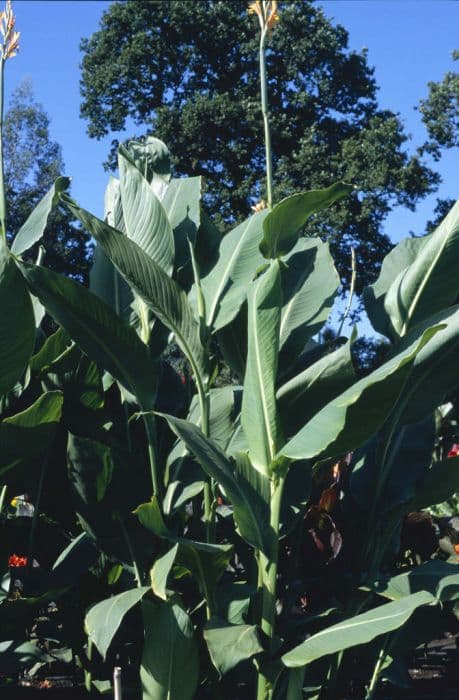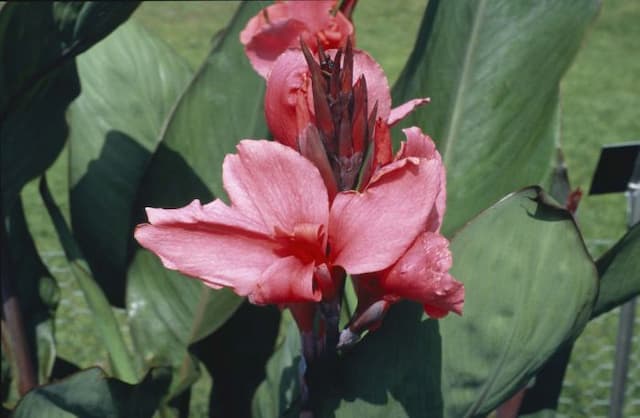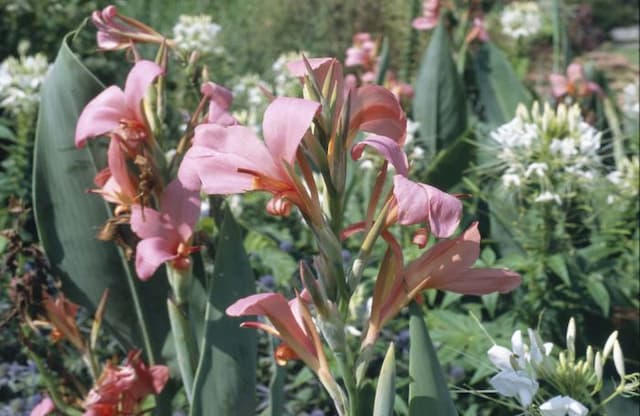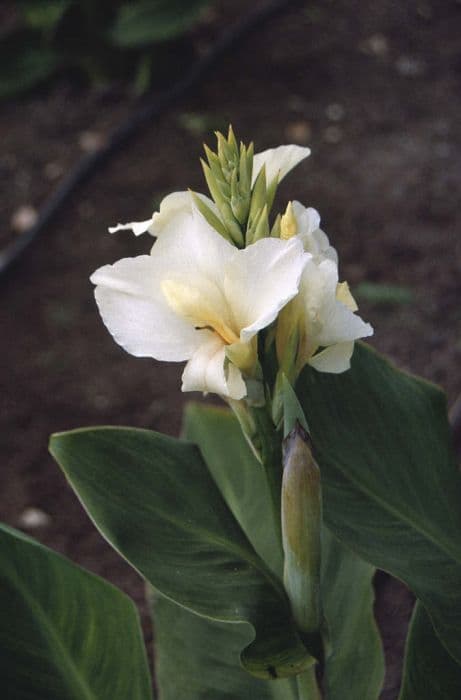Canna Lily Canna 'Louis Cayeux'

ABOUT
The Canna 'Louis Cayeux' is a striking plant known for its vibrant and showy features. Its flowers are a warm, fiery shade of orange that often have a lustrous sheen, making them quite eye-catching. These blooms cluster at the top of the stalks, and their petals have a gently ruffled appearance that adds to their lush and exotic look. The foliage of the Canna 'Louis Cayeux' is equally impressive with large, banana-like leaves that are broad and elongated, providing a lush background for the bright flowers. These leaves can vary in color from deep green to bronzy tones, which may even appear to have purplish hues depending on the light. The plant overall has a tropical aesthetic, feeling reminiscent of a vibrant, sun-filled garden atmosphere. The rhizomes, or root structures, of the Canna 'Louis Cayeux' are thick and flesh-like, which store nutrients to help the plant thrive and bloom. The overall structure of the plant is sturdy, able to support the substantial weight of its sizeable leaves and flower clusters that form at the top. In summary, the Canna 'Louis Cayeux' presents a lush display with its large, tropical-looking leaves and clusters of bright orange, ruffled flowers, creating an exotic and colorful addition to any garden.
About this plant
 Names
NamesSynonyms
Canna Lily, Indian Shot, Canna.
Common names
Canna 'Louis Cayeux'.
 Toxicity
ToxicityTo humans
Canna 'Louis Cayeux', commonly known as canna lily, is not considered toxic to humans. There are no significant toxic effects reported from ingesting parts of this plant. It is generally recognized as safe to have in gardens and landscapes where children or adults might come into contact with it.
To pets
Canna lily is also not considered toxic to pets such as cats and dogs. There is no evidence suggesting that ingestion of canna lily parts causes any significant toxic symptoms in pets. However, as with any plant material, ingestion in large amounts could potentially cause mild stomach upset due to the fibrous plant matter, but this is not related to toxicity.
 Characteristics
CharacteristicsLife cycle
Perennials
Foliage type
Deciduous
Color of leaves
Green
Flower color
Orange
Height
4-5 feet (1.2-1.5 meters)
Spread
1.5-2 feet (0.45-0.6 meters)
Plant type
Bulb
Hardiness zones
7
Native area
South America
Benefits
 General Benefits
General Benefits- Ornamental Value: With its striking foliage and vibrant flowers, Canna 'Louis Cayeux' adds visual appeal to gardens and landscapes.
- Attracts Pollinators: The bright blooms of the canna lily attract bees, butterflies, and hummingbirds, promoting biodiversity.
- Ease of Care: Canna lilies are relatively easy to maintain, requiring minimal care once established, making them suitable for various skill levels of gardeners.
- Quick Growth: This plant grows quickly, providing a fast option for creating visual impact in new or established gardens.
- Tolerance to Moisture: Canna lilies can tolerate wet conditions, making them ideal for planting in areas prone to moisture or near water features.
- Multiple Uses: They can be used in a variety of garden settings, including borders, containers, and waterside plantings.
- Versatility: Canna 'Louis Cayeux' comes in different sizes and can be used to complement both large and small garden spaces.
 Medical Properties
Medical PropertiesThis plant is not used for medical purposes.
 Air-purifying Qualities
Air-purifying QualitiesThis plant is not specifically known for air purifying qualities.
 Other Uses
Other Uses- Edible Rhizomes: The rhizomes of Canna 'Louis Cayeux' can be cooked and eaten like a root vegetable, offering a starchy component to dishes similar to potatoes or yams.
- Livestock Feed: The foliage can be used as forage for livestock, providing an additional source of nutrition for animals such as pigs or goats.
- Paper Production: The fibrous content of Canna 'Louis Cayeux' stems can be utilized in the making of paper or cardboard, offering an alternative to traditional wood pulp.
- Fishing Aid: The buoyant seeds can be strung on lines as natural floats in some traditional fishing practices.
- Plant Starch: The rhizomes are rich in starch that can be extracted and used as a vegan thickening agent in cooking and baking, similar to cornstarch or arrowroot.
- Biofuel Source: The biomass of Canna 'Louis Cayeux' can contribute to the production of bioethanol, a renewable energy source.
- Natural Dye: The bright flowers can be used in the production of natural dyes for textiles, yielding vibrant colors when the proper mordants are used.
- Ornamental Fish Ponds: The plant can be used in ornamental water gardens and fish ponds to provide shelter for fish and help maintain water quality.
- Erosion Control: With its dense growth habit, it can be planted on slopes or along waterways to help stabilize soil and prevent erosion.
- Biodegradable Containers: The leaves and stems, when dried, can be molded into biodegradable pots for plant seedlings, which can be planted directly into the ground.
Interesting Facts
 Feng Shui
Feng ShuiThe plant Canna is not used in Feng Shui practice.
 Zodiac Sign Compitability
Zodiac Sign CompitabilityThe plant Canna is not used in astrology practice.
 Plant Symbolism
Plant Symbolism- Beauty: The Canna 'Louis Cayeux', commonly known as Canna Lily, is often associated with beauty due to its large, bold, and vibrant flowers.
- Confidence: Its striking appearance can symbolize self-assurance and confidence, inspiring onlookers to stand tall and be proud.
- Love: The warmth of its colors, often associated with passion and affection, can symbolize a fiery love or romantic desire.
- Fertility: Canna Lilies, with their robust growth and prolific blooms, are sometimes connected to fertility and abundance in life.
- Change: As the Canna Lily goes through a cycle of growth, blooming, and renewal, it can represent change or a new phase in life.
 Water
WaterCanna Lilies, including the variety 'Louis Cayeux', should be watered regularly to keep the soil consistently moist but not waterlogged. During the growing season, water them every few days, providing about 1 to 2 inches of water each week, depending on the climate and soil drainage. They may require more frequent watering in high temperatures or less in cool, cloudy conditions. On average, this equates to approximately 0.5 to 1 gallons per plant per week, ensuring deep irrigation to promote root growth.
 Light
LightCanna Lilies prefer full sun with at least 6 to 8 hours of direct sunlight a day to thrive and produce the best blooms. Planting 'Louis Cayeux' in a spot that gets plenty of sunshine throughout the day will ensure vibrant flowers and healthy growth. However, they can also tolerate partial shade, especially in the hottest parts of the day, but flowering might be reduced.
 Temperature
TemperatureCanna Lilies are tropical plants, and 'Louis Cayeux' prefers warm conditions. Temperatures between 70°F and 90°F are ideal for growth and flowering. They can survive minimum temperatures of around 60°F but should not be exposed to frost. In colder climates, the rhizomes can be overwintered indoors once the temperatures drop below 50°F.
 Pruning
PruningPruning Canna Lilies primarily involves deadheading the spent flowers to encourage new blooms and removing old foliage. 'Louis Cayeux' should be pruned by cutting back the flower stalks after blooming and removing brown leaves to maintain its appearance. This can be done throughout the growing season. After the first frost in autumn, cut the plants down to a few inches above ground level if they are in a region with cold winters.
 Cleaning
CleaningAs needed
 Soil
SoilCannas thrive in rich, well-draining soil with a pH of 6.0 to 6.5. The best soil mix for Canna 'Louis Cayeux' would a combination of garden soil, compost, and perlite or coarse sand to ensure proper drainage. It's important the soil is fertile and kept moist, especially during the growing season.
 Repotting
RepottingCanna 'Louis Cayeux', like other cannas, should be repotted every 2 to 3 years or when the rhizomes outgrow the pot. The best time to repot is in the spring, at the beginning of the growing season, and it provides an opportunity to divide the rhizomes if necessary.
 Humidity & Misting
Humidity & MistingCannas, including Canna 'Louis Cayeux', prefer higher humidity levels, around 50-70%. However, they are adaptable and can tolerate a wide range of humidity conditions as long as they are regularly watered and cared for which helps them manage variable humidity.
 Suitable locations
Suitable locationsIndoor
Place in bright, indirect light and keep soil consistently moist.
Outdoor
Choose a sunny spot, keep soil moist, and shelter from strong winds.
Hardiness zone
7-10 USDA
 Life cycle
Life cycleCanna 'Louis Cayeux', commonly known as Canna Lily, begins its lifecycle as a seed or more commonly, a rhizome, which is planted in the soil. Upon germination or wake from dormancy in spring, the rhizome sends up shoots that develop into large green to bronze-red leaves, forming a clumping foliage. Throughout the summer, the plant produces tall flower stalks with colorful, iris-like blooms that can be red, orange, or yellow. After the flowering period, the blooms fade, and seed pods may form, although many cultivars are sterile and do not produce viable seeds. As temperatures cool down in autumn, the above-ground foliage dies back, and the plant enters a dormant phase, where the rhizome survives underground. With the return of warm temperatures in the following spring, the cycle recommences with new growth sprouting from the rhizome.
 Propogation
PropogationPropogation time
Spring-Early Summer
The Canna 'Louis Cayeux', commonly known as Canna Lily, is most commonly propagated through division of its rhizomes. The ideal time for this is in the spring, just before the growing season begins, when the rhizomes have stored energy for new growth. To propagate, carefully lift the rhizome clump from the ground, and using a clean, sharp knife, divide the rhizome ensuring each section has at least one eye, which is a growth point for new shoots. These sections can then be planted about 4 inches deep (about 10 cm) and spaced approximately 18 to 24 inches apart (45 to 60 cm). Keep the soil moist and expect new growth to emerge in a few weeks.









